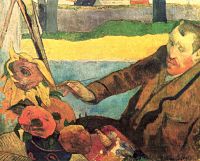Everyone’s heard a story about some successful businessperson who dumped a 20-year career to pursue something completely different and is happier for it.
The famous Impressionist painter, Paul Gauguin, for example, ditched a lucrative banking career and bourgeois life in Paris to paint full-time in the Polynesian islands.
Most people who want to make a midlife career change never take such drastic action because they fear change and don’t want to make sacrifices—at least that’s the common job change advice. I suggest this is incorrect.
I’m sure Gauguin feared change and didn’t want to make sacrifices but did so anyway. What motivated him to do so, and why do so many people who feel stuck in a career, unable to take action to get unstuck?
Like most people, Gauguin got an education that led to a particular career path. His vocation was fixed but some years later he decided he wasn’t a banker anymore. Like others, he probably said to himself, “If I don’t make a move now, I never will, and I’ll live to regret it.” But the truth is Gauguin didn’t know how to make a career change.
A successful transition requires effective actions
Gauguin’s first action was not to jump on a boat and sail to the South Pacific. He didn’t start with an “aha!” experience then go out and try to find it. No, he spent years painting.
He learned to paint, hung out with other artists, and explored the art world, learning not only his craft but the business of art. Transition is a process based on actions. As a job change expert, I know that the motivation underlaying those actions is the key to a successful transition.
Gauguin knew what he wanted to do—paint. But that’s not enough for change. Many people figure out what they want to do but nothing comes of it. Why?
Gauguin remolded his deepest values and highest aspirations. Instead of producing wealth, he decided it was more important for him to produce beauty, his deepest value. In order to produce beauty, he decided to paint full-time, his deepest aspiration.
Changing careers means redefining our working identity—who and what we are in terms of our right work, what we communicate about ourselves to others and, ultimately, how we live our working lives.
Who we are and what we do—our BEING and our DOING–are closely connected, the result of years of certain actions. And to change that connection, we must first resort to other actions that align with our deepest values and highest aspirations. This is the source of motivation for a midlife change.
As a painter, Gauguin didn’t make much money but loved his new life. The feeling—the intrinsic reward, the emotional value–that he gained from painting aligned with his deepest values and highest aspirations, a feeling he couldn’t get from banking.
A picture of a future that feels better
In other words, change occurs when we have a picture of a better alternative to our current identity, one that feels better. My clients who have made successful changes know this feeling well.
That is the purpose of my JobJoy Report — to give you a picture of a new working identity, one that aligns with your BEING. It will help you visualize a specific outcome, something different than the one you are now stuck in.
My JobJoy Report will start you moving in a new direction because you will be motivated to make a change, by DOING new things that feel better.
Once you experience those positive feelings, by taking different actions, you will make a successful career change and live a better story. Oh, what a feeling…what a rush!

